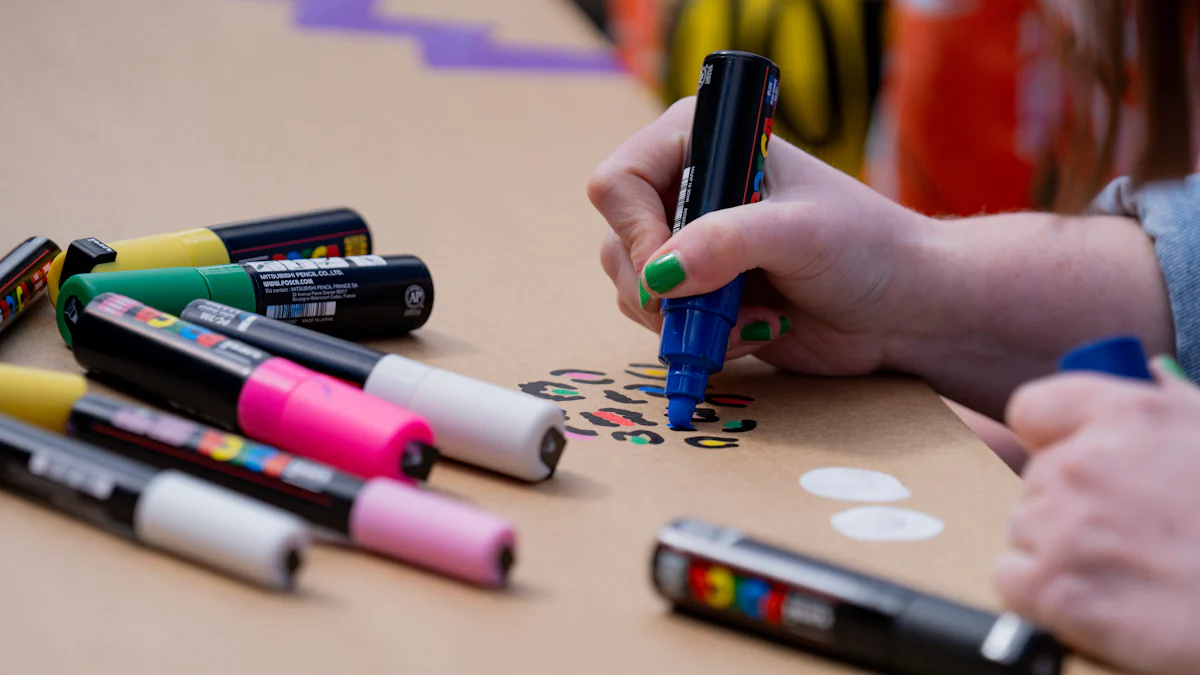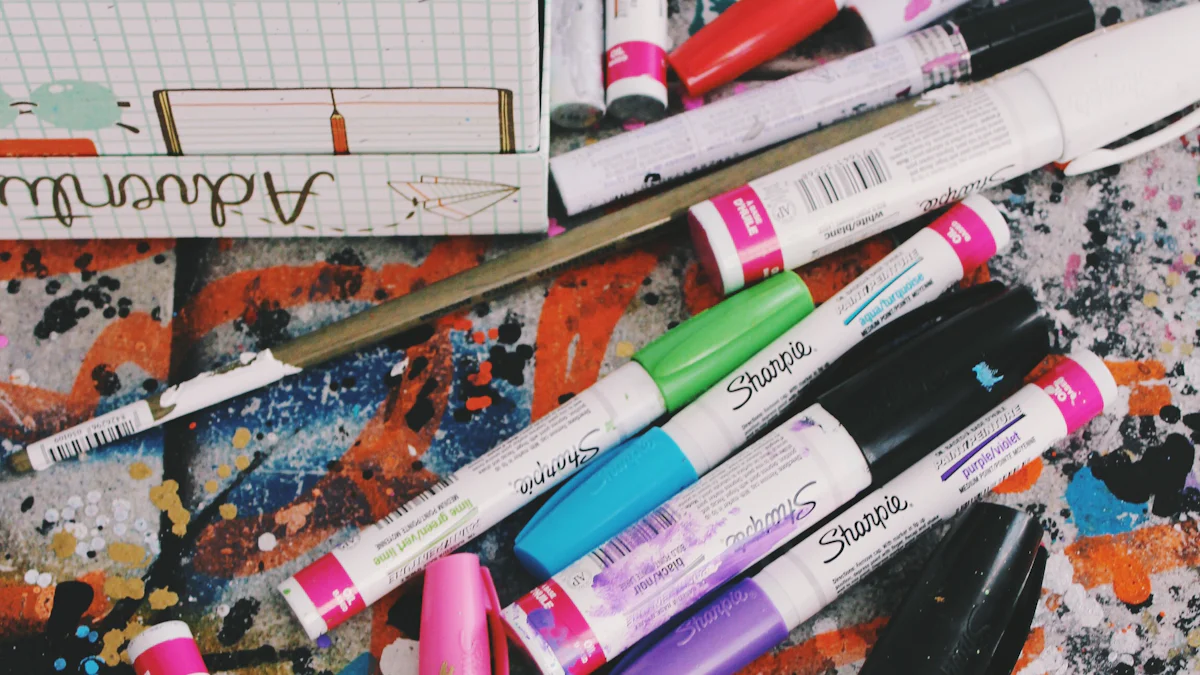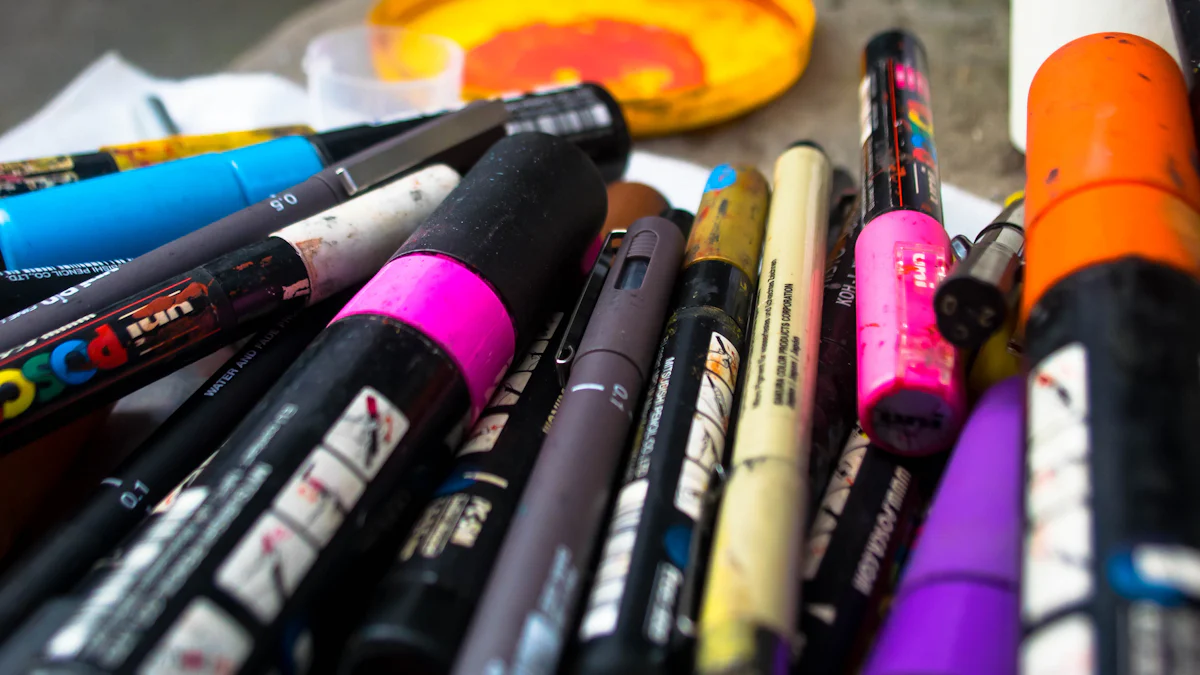
Have you ever wanted to create vibrant, detailed art without the mess of traditional paints? Acrylic paint markers might be your new favorite tool! These markers combine the bold finish of acrylic paint with the control of a pen. Artists love them because they’re easy to use, durable, and perfect for DIY projects. Whether you’re customizing sneakers or painting rocks, tools like TWOHANDS Acrylic Paint Markers,12 Colors,20116 make it simple to bring your ideas to life. Plus, with options like TWOHANDS Metallic Paint Markers,Gold & Silver,20918, you can add a touch of shimmer to your creations. No brushes, no spills—just creativity at your fingertips!
Key Takeaways
- Acrylic paint markers mix bright paint colors with pen-like control.
- You can use them on wood, glass, fabric, and more.
- They are safe for kids and great for family crafts.Always check rules before using them on anything for food.
Unique Features of Acrylic Paint Markers

Composition and Water-Based Formula
Let me tell you why the composition of acrylic paint markers is so special. These markers use a water-based formula that combines acrylic pigments with a non-toxic solvent. This solvent includes glycol ether and ethanol, which makes the markers safe to use while still delivering excellent performance. I love how this formula balances safety with vibrant results. Plus, it’s environmentally friendly, so you can create without guilt. The water-based nature also means the paint flows smoothly, dries quickly, and is easy to layer.
Differences from Traditional Markers and Paints
You might wonder how acrylic paint markers compare to traditional markers or paints. Here’s the deal:
- Acrylic markers use high-quality acrylic paint, while traditional markers rely on water-based or alcohol-based ink.
- They offer long-lasting, permanent results, unlike regular markers that fade over time.
- The coverage is amazing! You get smooth application and bold, opaque lines.
Compared to traditional paints, acrylic paint markers are less messy and easier to control. You don’t need brushes or palettes, which makes them perfect for beginners. Experienced artists also love them for detailed work. Whether you’re outlining or filling in, these markers make it simple.
Benefits of Using Acrylic Paint Markers
Acrylic paint markers are a game-changer for so many reasons. First, they’re super easy to control. You don’t need any special tools, and cleanup is a breeze—no brushes to rinse or spills to wipe up. They also dry quickly, so you don’t have to worry about smudging. But here’s the best part: they’re versatile. You can use them for outdoor murals, wearable art like shoes, or even functional items like cups. The designs stay vibrant and durable, no matter where you use them.
Applications of Acrylic Paint Markers
Suitable Surfaces (Canvas, Glass, Wood, etc.)
One of my favorite things about acrylic paint markers is how versatile they are. You can use them on so many surfaces! They work beautifully on porous materials like wood, fabric, paper, and stone. The paint dries permanently on these surfaces, which makes them perfect for long-lasting projects. For non-porous surfaces like glass, metal, or ceramic, the paint still looks amazing, but it might chip over time if not sealed properly. I’ve even used them on leather and rubber for custom designs, and they hold up surprisingly well. Whether you’re painting on a canvas or decorating a mirror, these markers make it easy to get creative.
Popular Uses (Rock Painting, Customizing Shoes, etc.)
Acrylic paint markers are a go-to tool for so many fun projects. Here are some popular ways people use them:
- Custom sneakers: I’ve seen plain shoes transformed into wearable art with just a few strokes.
- Rock painting: These markers are perfect for adding intricate designs to rocks for decoration or gifts.
- Glass jar art: Decorating jars or bottles is a great way to create unique home decor or personalized presents.
- Upcycled furniture: Old furniture gets a new life with bold, colorful designs.
- DIY phone cases: You can turn a plain phone case into a one-of-a-kind accessory that reflects your personality.
The possibilities are endless, and the results are always stunning.
Creative Project Ideas
If you’re looking for inspiration, I’ve got a few ideas to get you started. Try customizing a pair of sneakers with bold patterns or your favorite characters. You could also decorate a set of mugs or plates for a personalized gift. I’ve even used acrylic paint markers to create mixed-media art by combining them with watercolors and collage materials. Another fun idea is to design your own bookmarks or greeting cards. These markers make it easy to add vibrant details to any project. Let your imagination run wild!
Safety and Precautions
Non-Toxic and Kid-Safe Features
One of the best things about acrylic paint markers is their non-toxic formula. I feel confident using them around kids because they’re safe and easy to handle. Whether it’s a family craft day or a school art project, these markers are a great choice. However, I always recommend checking the label before handing them to children. Some brands may have specific age recommendations. Supervision is also a good idea, especially for younger kids, to ensure they use the markers properly.
Food-Related Uses and Limitations
I often get asked if acrylic paint markers can be used on plates, mugs, or other items that touch food. Here’s the truth: they’re not food-safe. Even though many markers are labeled non-toxic, that doesn’t mean they’re safe for surfaces that come into contact with food. If you’re decorating a mug or plate, keep the designs on the outside or areas that won’t touch food. Always check the product’s safety guidelines to be sure.
Proper Storage and Handling
Taking care of your acrylic paint markers is key to keeping them in great shape. I’ve learned a few tricks over time:
- Clean the surface you’re working on before starting. This helps the paint stick better.
- Apply multiple layers for a bold look, letting each layer dry completely before adding the next.
- Use a sealant to protect your designs, especially on items exposed to water or wear.
- Handle your finished artwork gently, especially in the first few days after sealing.
Proper storage matters too. I always store my markers horizontally to prevent the paint from drying out. Keeping the caps tightly closed also helps maintain their quality.
Techniques for Using Acrylic Paint Markers

Layering and Blending
Blending colors with acrylic paint markers is one of my favorite techniques. It’s so satisfying to see smooth gradients come to life! Here’s how I do it:
- Work while the paint is still wet. This makes blending easier and creates soft transitions between colors.
- Once the first layer dries, add another color to create depth or highlights.
- Use a blending tool, like a small brush or sponge, for a polished look.
I’ve found that layering is also great for building up bold, opaque colors. Just let each layer dry completely before adding the next. This prevents smudging and keeps the colors vibrant.
Pro Tip: Experiment with blending on scrap paper first. It helps you get a feel for how the colors mix!
Outlining and Detailing
Adding outlines and details can make your artwork pop. I always use an extra fine nib for precise borders or intricate designs. For very thin outlines, thin-tipped permanent markers or glass pens work wonders.
Here’s what I’ve learned about detailing:
- Fine tips (1mm or less) are perfect for small patterns and delicate work.
- Medium tips (2-4mm) are better for general drawing or medium-sized details.
- Broad tips are ideal for bold strokes or filling large areas.
Acrylic paint markers are amazing for highlights and patterns. Their rich pigment makes even the smallest details stand out beautifully.
Tips for Long-Lasting Results
If you want your artwork to last, preparation is key. I always clean the surface before starting to ensure the paint sticks well. For more vibrant results, I apply multiple layers, letting each one dry completely.
To protect your designs, use a sealant—especially for items exposed to water or friction. I also avoid placing finished pieces in direct sunlight, as it can fade the colors over time.
Note: Handle your artwork gently, especially in the first few days after sealing. This gives the paint time to fully cure.
By following these tips, you’ll keep your creations looking fresh and vibrant for years!
Acrylic paint markers are a must-have for any creative toolkit. They’re versatile, easy to use, and perfect for beginners and pros alike. I love how they work on so many surfaces, from canvas to glass. With quick-drying, vibrant colors and precise nibs, these tools make every project a breeze. Explore, experiment, and let your imagination shine!
FAQ
How do I fix a clogged acrylic paint marker?
Shake the marker well, then press the nib on scrap paper to restart the flow. If it’s still clogged, rinse the nib with warm water.
Tip: Always store markers horizontally to prevent clogging.
Can I use acrylic paint markers on fabric?
Yes! They work great on fabric. Just heat-set the design with an iron after it dries to make it permanent and washable.
Note: Test on a small area first to check compatibility.
Are acrylic paint markers waterproof?
Once dry, most acrylic paint markers are water-resistant. For extra protection, seal your artwork with a clear spray or varnish, especially for outdoor projects.
Pro Tip: Use a UV-resistant sealant to prevent fading in sunlight.
Post time: Feb-02-2025


